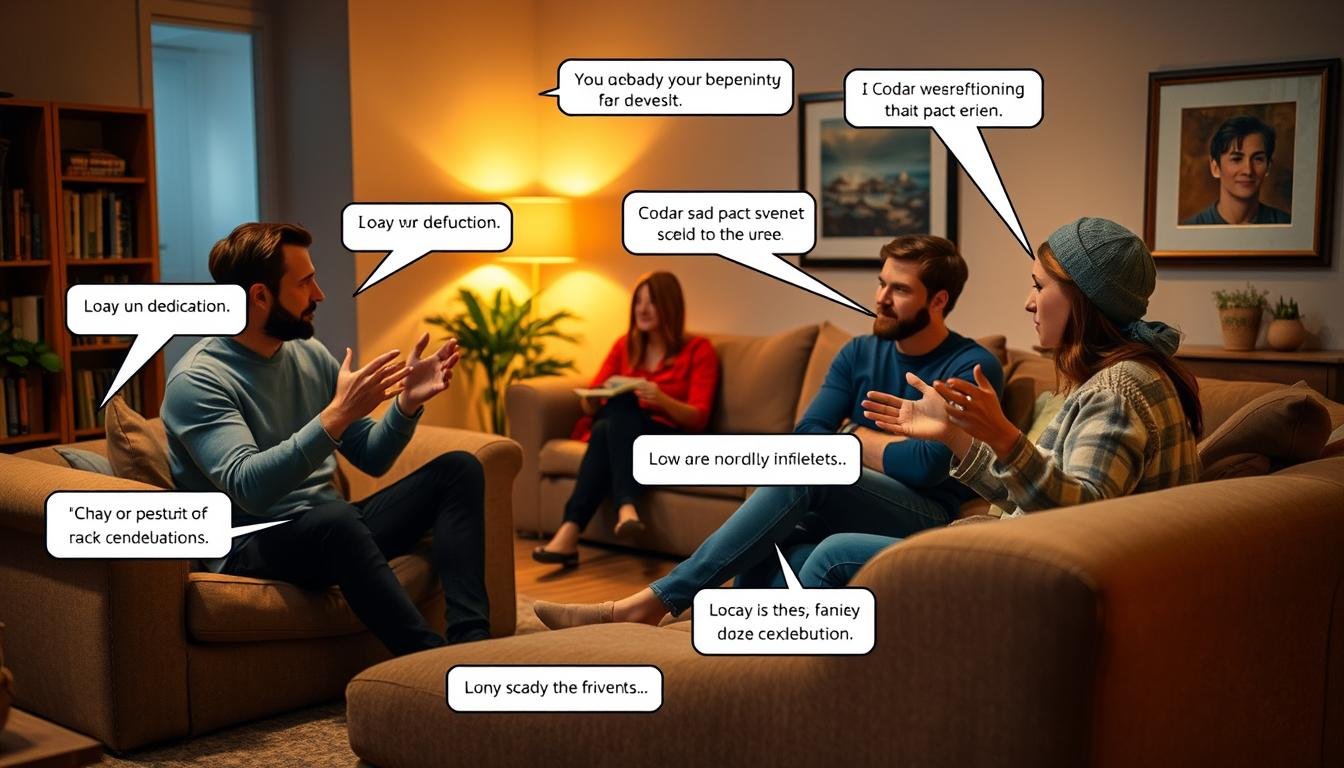Now Reading: Understand the Present Simple Tense | LearnEnglish
-
01
Understand the Present Simple Tense | LearnEnglish
Understand the Present Simple Tense | LearnEnglish

Understand the Present Simple Tense | LearnEnglish
Whether you’re starting out or improving your skills, the present simple tense is key. This learnenglish guide shows how it’s used in everyday life and beyond. It’s why even those who are good at English still check its rules.

Key Takeaways
- Use present simple for habits, facts, and scheduled events like “The Earth orbits the sun.”
- Structure english grammar sentences with subject + base verb (e.g., “She walks to school”).
- Third-person singular verbs add -s, -es, or irregular forms (e.g., “He teaches math”).
- Avoid mixing it with actions in progress to prevent confusion with present continuous.
- Practice real-world scenarios like giving directions or stating scientific truths.
What is the Present Simple Tense?
The present simple tense is key to basic English talk. It helps us share daily actions, truths, and habits. Learning it helps build a solid base for english grammar.
Definition and Basic Concept
This tense talks about regular actions or constant facts. Its form changes based on the subject and the verb:
| Subject | Verb Form |
|---|---|
| I/we/you/they | work |
| he/she/it | works |
The Present Simple in English Grammar
The present simple is a main part of english grammar. It’s used more than any other tense. It shows permanent states, not ongoing actions.
Why Master This Fundamental Tense
- Essential for daily conversations
- Necessary for reading comprehension
- Foundation for learning advanced verb tenses
Without this basic English structure, it’s hard to talk about routines or facts. Using examples like “Birds fly” or “She reads books daily” helps practice it right.
When to Use the Present Simple Tense
The present simple tense is key for clear English talk. Let’s look at times when it’s perfect:
Habits and Daily Routines
For regular actions, use the present simple. For example: “She drinks coffee every morning” or “They walk the dog daily.” These show actions done every day without fail.
Facts and General Truths
Share universal facts or truths: “Birds fly south in winter” or “Water freezes at 0°C.” These facts are always true, no matter the time or place.
Scheduled Events and Timetables
Timetables use present simple for future plans. For instance: “The library opens at 8 AM tomorrow.” Here’s a table for more examples:
| Event | Time |
|---|---|
| School starts | 8:30 AM |
| Flight departs | 6:15 PM |
Instructions and Directions
Recipes or guides use this tense for steps: “Mix flour and sugar” or “Turn left at the post office.” It makes sure instructions are clear.
Learning these examples boosts your confidence in using the present simple. Check out learnenglish for fun exercises to practice.
Formation Rules of Present Simple
Learning the formation rules of the present simple tense is crucial for basic english. For subjects like I, you, we, and they, the verb stays the same. For instance: “We run,” “You learn,” or “They eat.”
The rules are simple, but there’s a twist for third-person singular forms (he, she, it).
For third-person singular verbs, there are specific patterns. Most verbs add -s: “She walks,” “He works.”
Verbs ending in consonant + y change to -ies, such as “study” → “studies.”
For verbs ending in s, sh, ch, x, z, add -es: “He watches,” “It fixes.”
- Base verb rule: Use unchanged for all except third-person singular.
- -s addition: Apply to most third-person verbs (e.g., “He teaches”).
- -es rule: Add for verbs ending in s, sh, ch, x, z (e.g., “The bus stops”).
- -y to -ies: Change verbs like “carry” → “carries”.
These rules are key to building basic english sentences. Practice with verbs like “play” → “She plays” or “watch” → “They watch.” Knowing these rules helps in clear communication and writing in english grammar.
Present Simple | LearnEnglish Core Principles
Mastering the present simple starts with understanding its basic structures. Begin with affirmative sentences using the formula: subject + base verb. For example: “She studies French” or “They travel often.”
Third-person singular adds an -s to the verb: “He walks daily.”
Negative forms use do not/doesn’t + base verb. Use “don’t” for all subjects except third-person singular: “We don’t cook dinner” vs. “He doesn’t cook.”
Verbs go back to their base form in third-person negatives.
Form questions by placing do/does before the subject: “Do children learn quickly?” or “Does the library open early?” Wh-questions follow the same pattern: “What time does the train arrive?”
- Affirmative: I/you/we/they + base verb
- Negative: Subject + don’t/doesn’t + base verb
- Question: Do/Does + subject + base verb?
These rules work for all sentence types. Practice these patterns to improve your learnenglish skills.
Third Person Singular: Special Considerations
Learning third person singular forms in the present simple is key. It involves understanding rules that shape English grammar. These rules help us use examples like “he walks” or “she thinks” correctly.
Adding -s, -es, or -ies
Follow these spelling changes for verb endings:
| Rule | Example | Third Person |
|---|---|---|
| Add -s to most verbs | play | plays |
| Add -es after s, sh, ch, x, z, or o | watch | watches |
| Change consonant + y to -ies | study | studies |
Examples like “go → goes” show how -o verbs take -es. Remember, vowel + y endings keep -s, not -ies. This avoids mistakes like “playies.”
Irregular Verbs in Third Person
Irregular verbs don’t follow standard rules. Key exceptions include:
- have → has
- do → does
- go → goes (despite the -es ending)
When saying third-person endings, pay attention to pronunciation. Verbs like “watches” use /ɪz/ sounds. Don’t add -s to irregular forms like *dos*.
Common Time Expressions with Present Simple
Learning time expressions is crucial for using the Present Simple correctly in basic english. These phrases help show routine actions or facts. They make it easier for learners to create accurate sentences. Let’s look at how time expressions work with this tense through clear examples.

| Expression Type | Time Expression | Example |
|---|---|---|
| Frequency Adverbs | Always | I always drink coffee in the morning. |
| Usually | Students usually study in libraries. | |
| Specific Times | Every day | She walks her dog every day. |
| On Mondays | The shop opens on Mondays. | |
| General Expressions | Nowadays | Nowadays, most people use smartphones. |
| Currently | They currently live in New York. |
Adverbs like often or sometimes show how often something happens. Use them before the verb: “He sometimes reads books.” Phrases like every week or twice a month set specific times. General terms like these days point out trends.
Practice these patterns with online lessons to see them in action. For example: “Birds migrate every autumn,” or “We never forget to lock the door.” These examples make learning practical and useful.
Present Simple vs. Present Continuous
Learning english grammar rules helps avoid confusion. The present simple and present continuous describe current actions. But they have different uses in contexts.
Key Differences in Usage
Let’s compare these structures:
- Present simple: For habits (“She reads books daily”) or facts (“Water boils at 100°C”).
- Present continuous: For actions in progress (“They are writing emails now”) or temporary states (“We are living in Paris this year”).
Choosing the Right Tense
Use present simple with stative verbs like believe, want, or hear. Don’t use continuous forms here: “He believes in change” (correct) vs. “He is believing” (incorrect).
Avoiding Common Errors
Beginners often mix these tenses when talking about ongoing actions. Mistakes like “She is knowing the answer” use stative verbs in the wrong way. Practice to tell permanent from temporary situations to get better.
Practice Exercises for Building Mastery
Learning well means practicing often. Practice exercises help you get better at the present simple tense. Start with basic tasks and then move to more real-life uses.

Beginner Level Exercises
Start with simple examples like filling in verbs. For example, “She ___ (eat) breakfast at 8 AM.” Use verb lists for daily activities like waking up, working, and studying. Sites like Duolingo offer fun online lessons with quick feedback.
Intermediate Applications
Move on to fixing mistakes in sentences. For example, “He goes to school every day but yesterday.” You’ll rewrite sentences with the right tense. Try changing sentences into different forms, like negative or questions, to improve your skills.
Real-World Usage Scenarios
Use your skills in real-life situations. For example, write a recipe using the present simple tense: “Mix ingredients, bake at 350°F.” Practice conversations about daily habits or facts, like “Birds migrate seasonally.” These examples help you understand how to use the tense in everyday talk.
- Self-check answer keys clarify errors immediately
- Interactive online lessons provide dynamic practice
- Authentic examples ensure practical understanding
Regular practice makes using the tense second nature. Begin with guided exercises and then try more open-ended ones to boost your confidence.
Common Mistakes to Avoid
Learning the present simple tense is key. It’s important to follow english grammar rules closely. Many people make mistakes that can confuse others. Here are some common errors and how to fix them:
- Third-Person Singular Errors Don’t forget to add -s for he/she/it. Example: Incorrect: “She go to school.” → Correct: “She goes to school.”
- Auxiliary Verb Omissions Questions and negatives need do/does. Example: Incorrect: “? You like pizza?” → Correct: “Do you like pizza?”
- Word Order Confusion In questions, use “auxiliary + subject + verb.” Example: Incorrect: “Eats he breakfast?” → Correct: “Does he eat breakfast?”
| Mistake Type | Incorrect Example | Correct Form | Rule Violated |
|---|---|---|---|
| Adverb Placement | “She sometimes study.” → “She studies sometimes.” | Adverbs often follow the main verb | |
| Tense Misuse | “I am eating lunch daily.” → “I eat lunch daily.” | Present simple for routines, not actions in progress |
These examples show how small mistakes can change meaning. Regularly reviewing rules helps improve accuracy. Practice spotting corrections in daily conversations to get better at speaking.
Advanced Uses of the Present Simple
The present simple is not just for habits and facts. It also has advanced uses. These uses make stories, predictions, and conditions more interesting.
Narrative and Historical Present
Stories and history often use the present tense for a sense of now. For example:
- “She enters the room and announces the news.” (Narrative)
- “In 1492, Columbus discovers America.” (Historical retelling)
Future Meaning in Certain Contexts
Timetables and plans use the present simple for what’s coming up:
- “The concert starts at 8 PM tomorrow.” (Scheduled events)
- “They arrive next week—prepare the meeting room.” (Future certainty)
Conditional and Time Clauses
In conditional sentences, the present simple shows possible futures:
- “If she wins, she donates the prize money.” (Future condition)
- “When he finishes, we celebrate.” (Time clause)
| Use Case | Example | Context |
|---|---|---|
| Narrative | “He suddenly sees a shadow.” (Storytelling) | Immediacy effect |
| Scheduled Future | “The flight departs at 6:00 AM.” (Travel plans) | Official timetables |
| Conditionals | “If you come early, you get a gift.” (Promotions) | Hypothetical scenarios |
Conclusion
The present simple tense is key in everyday English. It helps us talk about routines, facts, and schedules clearly. Its simple structure makes it easy to share habits or truths.
Practice is crucial to get better at using the present simple. Sites like LearnEnglish offer fun drills. These help learners practice making sentences, negatives, and questions.
Choosing the right verb tense is important for clear communication. The present simple is essential for both formal writing and everyday chats. Learn more about past and future tenses on LearnEnglish to improve your skills. With ongoing practice, you’ll become more confident in expressing yourself.






























